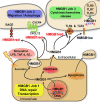The Multitasking Potential of Alarmins and Atypical Chemokines
- PMID: 30729111
- PMCID: PMC6351468
- DOI: 10.3389/fmed.2019.00003
The Multitasking Potential of Alarmins and Atypical Chemokines
Abstract
When the human genome was sequenced, it came as a surprise that it contains "only" 21,306 protein-coding genes. However, complexity and diversity are multiplied by alternative splicing, non-protein-coding transcripts, or post-translational modifications (PTMs) on proteome level. Here, we discuss how the multi-tasking potential of proteins can substantially enhance the complexity of the proteome further, while at the same time offering mechanisms for the fine-regulation of cell responses. Discoveries over the past two decades have led to the identification of "surprising" and previously unrecognized functionalities of long known cytokines, inflammatory mediators, and intracellular proteins that have established novel molecular networks in physiology, inflammation, and cardiovascular disease. In this mini-review, we focus on alarmins and atypical chemokines such as high-mobility group box protein-1 (HMGB-1) and macrophage migration-inhibitory factor (MIF)-type proteins that are prototypical examples of these classes, featuring a remarkable multitasking potential that allows for an elaborate fine-tuning of molecular networks in the extra- and intracellular space that may eventually give rise to novel "task"-based precision medicine intervention strategies.
Keywords: MIF protein family; alarmin; cardiovascular disease; chemokine; cytokine; inflammation; moonlighting; promiscuity.
Figures


References
Publication types
LinkOut - more resources
Full Text Sources
Research Materials
Miscellaneous

